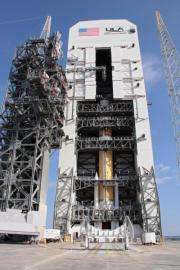GOES-P proceeds toward launch

The latest Geostationary Operational Environmental Satellite, GOES-P is proceeding through more checks in preparation for its launch, which is no earlier than March 1.
The GOES-P spacecraft continues being processed at the Astrotech Facility in Titusville, Fla. The Imager, Sounder and Solar X-Ray Imager have completed cleaning and inspections. The optical port covers have been successfully installed. Those covers are one of the last mechanisms to be deployed once GOES-P gets into orbit.
GOES-P is the latest weather satellite developed by NASA to aid the nation's meteorologists and climate scientists. GOES satellites provide the familiar weather pictures seen on United States television newscasts every day. GOES provides nearly continuous imaging and sounding, which allows forecasters to better measure changes in atmospheric temperature and moisture distributions, which increase the accuracy of their forecasts. GOES environmental information is used for a host of applications, including weather monitoring and prediction models.
Along with the instruments GOES-P will carry, it also contains seven appendages and mechanisms that are stowed for launch and later deployed during transfer orbit or at various phases of on-orbit testing. Those deployable mechanisms and appendages are: Aft omni antenna; Deployable aft blanket (DAB); Solar array; X-ray positioner (XRP); Magnetometer boom; Instrument radiant cooler covers; and the optical port covers.
These seven mechanisms are put into operation after the Delta IV rocket deploys GOES-P into space. Here's the order of how they work: Shortly after separation from the launch vehicle on day one of Launch and Orbit Raising (LOR), the Aft omni and DAB are deployed. At about the twelfth day, once geosynchronous orbit is achieved, the solar array is deployed. The solar array powers GOES-P in orbit. At around day 13 or 14 the XRP is released, followed by the magnetometer boom. By around day 17 in orbit, the instrument optical port covers are deployed at the end of Bus In-Orbit Testing (IOT). Finally, after about 30 days in orbit the radiant cooler covers are deployed.
Two solid rocket boosters were installed on Jan. 15, 2010, on the Delta IV Launch Vehicle that will carry GOES-P into space. GOES-P was transferred to its fueling stand on Monday, January 18. The L-35 Countdown Launch Procedure (CLP) Rehearsal was successfully completed on January 19, and the next day, the Propulsion System Valve Driver Functional Testing was completed. Now, Propulsion System Pressurization and Leak Checks are in progress in preparation for fueling operations.
The Eastern Range has approved the GOES-P new launch date of March 1, 2010.
Provided by NASA's Goddard Space Flight Center

















